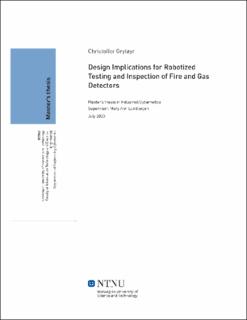| dc.contributor.advisor | Lundteigen, Mary Ann | |
| dc.contributor.advisor | Skofteland, Gunleiv | |
| dc.contributor.author | Grytøyr, Christoffer Andrè | |
| dc.date.accessioned | 2021-04-21T14:01:42Z | |
| dc.date.available | 2021-04-21T14:01:42Z | |
| dc.date.issued | 2020 | |
| dc.identifier.uri | https://hdl.handle.net/11250/2738943 | |
| dc.description.abstract | Abstract
The oil and gas industry has experienced a substantial increase in automated machinery and utilisation of process safety systems in the later years. The next frontier is the utilization of unmanned facilities, a costeffective alternative to subsea production systems, offering similar functionality and robustness. Robotics can be used to take on high-risk maintenance activities on an unmanned facility, limiting safety concerns regarding human operators.
This thesis will map detectors feasible for fire & gas (F&G) detection, and investigate how choice of detectors, installation, layout and requirements and regulations affects the choice of a robotic solution. Possibilities for unmanned offshore topside platforms are reviewed. Further, sensor selection and robotic design, including cases regarding robotic F&G detection procedures, are presented and discussed.
It was granted access to a company test procedure concerning F&G detection with the objective of changing an inspection procedure from human to robotic intervention. Further, design implications connected to the study cases are discussed, culminating in a choice ofwhich robotic design solution has the most potential for F&G detection on an unmanned facility.
It was concluded with an appropriate robotic solutions, adequately performing assignedtesting, inspection and maintenance tasks on an unmanned facility. The robotic design has been chosen based on prerequisites to be able to perform autonomous F&G detection on unmanned facilities. | en_US |
| dc.description.abstract | Sammendrag
Olje og gassindustrien har erfart en økende trend innenfor automatisert maskineri og bruk av prosessikre systemer de seneste årene. Den neste grensen er å bruke ubemannede innretninger, et kosteffektivt alternativ til produksjonssystemer på havbunnen, som tilbyr lignende funksjonalitet og robusthet. Robotikk kan benyttes til høy-risiko vedlikeholdsaktiviteter på ubemannede innretninger, som begrenser sikkerthetsbekymringer angående menneskelige operatører.
Denne masteroppgaven vil kartlegge relevante brann og gass (B&G) detektorer, og undersøke hvordan valg av detektorer, installasjoner, oppsett og krav påvirker valg av robotløsning. Det er videre gjennomgått muligheter for ubemannet fasiliteter toppside. Videre har det blitt sett på valg av sensorer og robotdesign, inkludert en diskusjon rundt caser angående B&G deteksjonsprosedyrer, gjennomført av en robot.
Det ble tildelt tilgang til et selskaps testprosedyrer angående B&G deteksjon. Målet var å endre prosedyrene fra menneskestyrt til robotstyrt. Videre ble designimplikasjoner tilknyttet casene diskutert. Dette førte til valg av hvilket robotdesign som har mest potensiale for B&G deteksjon på en ubemannet innretning.
Det ble konkludert med en passende løsning for robot, som kunne utføre testing, inspeksjon og vedlikeholdsoppgaver på en ubemannet innretning. Robotdesignet har blitt valgt basert på forutsetninger for å være i stand til å utføre automatiske B&G deteksjoner på en ubemannet innretning. | en_US |
| dc.language.iso | eng | en_US |
| dc.publisher | NTNU | en_US |
| dc.title | Design Implications for Robotized Testing and Inspection of Fire and Gas Detectors | en_US |
| dc.type | Master thesis | en_US |
